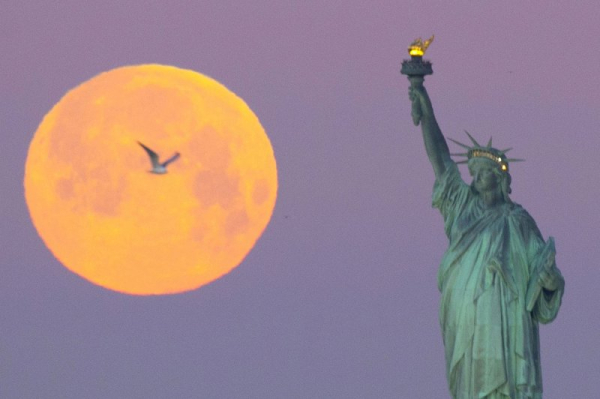Astronomical weekends in February will revolve around moon

A super snow moon sets behind the Statue of Liberty shorty after sunrise in New York City on February 19, 2019. File Photo by John Angelillo/UPI | License Photo
Weekend stargazers will get their fill in February as three of the four weekends throughout the month will feature an astronomical event, all of which revolve around the moon.
There will also be an additional night for enjoying the night sky this February since it is a leap year, meaning there will be 29 days and nights rather than the typical 28 during the second month of the year. Advertisement
No events in February require a telescope, but there will be good opportunities for folks to get a closer look with the help of a telescope. This includes people who may have received a new telescope during the holiday season but have yet to point it to the heavens.
From the antithesis of a supermoon to a tight-knit bunch of objects around a famous constellation, here are the three events you will not want to miss in February’s night sky: Advertisement
The second weekend of February will be the best time of the month for stargazing, not because of a meteor shower or a planetary alignment, but due to the absence of the moon.
On Feb. 9, the moon will reach its new phase, a time when it is not visible at night, making the night sky appear darker than other times of the month. While the new moon is a monthly occurrence, February’s wintry weather will help to give the stars an extra sparkle.
The amount of moisture in the atmosphere during the winter is lower compared to muggy summer nights. As a result, the stars during the winter months appear to twinkle more than they do any other time of the year.
However, the drawback is that a teeth-chattering chill often accompanies cloud-free nights during the winter, so sky watchers will need to bundle up before heading outside to soak in the sights of the cosmos.
A trio of celestial sights will gather in the sky during the third weekend of February, an event that will be easy for people of all ages to see — as long as clouds do not spoil the show.
After sunset on Feb. 17, the moon will appear above the constellation Orion in the southern sky. Jupiter will also be glowing in the same area of the sky to the right of the moon.
|
|
| The moon, Jupiter and Orion will glow together in the southern sky after sunset on Feb. 17. Image not to scale. Image courtesy of AccuWeather |
Advertisement
If cloudy weather prevails on Feb. 17, there will be additional opportunities to see the astronomical grouping on Feb. 18 and 19, although the moon will appear farther and farther away from Orion and Jupiter with each passing night.
Super moons have become viral sensations in recent years, but their smaller counterpart will glow in the sky near the end of the month.
As the moon orbits the Earth, there are times when it is closer to the planet, called perigee, and times when it is slightly farther away, known as apogee. February’s full moon will coincide with the time when it is farther away from the planet, resulting in a “micromoon,” which will appear about 14% smaller and 30% dimmer than a supermoon.
|
|
February’s full moon also has various nicknames, including the Snow Moon, the Bald Eagle Moon, the Bear Moon, the Hungry Moon and the Goose Moon.


